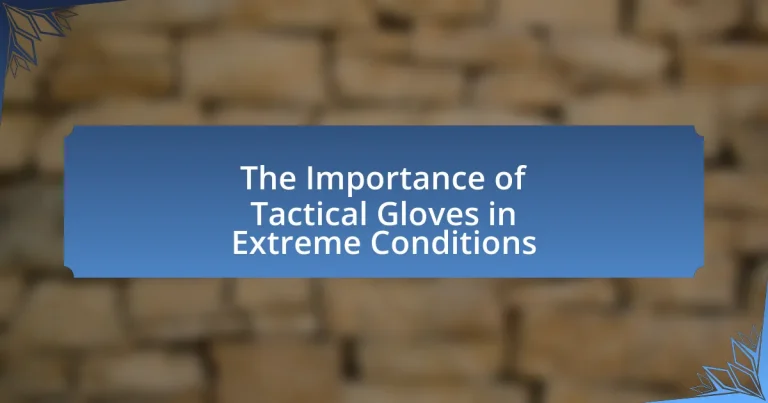Tactical gloves are specialized hand protection designed for use in extreme conditions, offering durability, grip, and dexterity essential for military personnel, law enforcement, and outdoor enthusiasts. This article explores the importance of tactical gloves, highlighting their unique features compared to regular gloves, the materials used in their construction, and the design elements that enhance functionality. It also discusses the protective roles these gloves play against environmental hazards, their impact on grip and dexterity, and best practices for selection, maintenance, and effective use in high-stress situations. Key features such as insulation, water resistance, and ergonomic design are emphasized to illustrate how tactical gloves improve safety and performance in demanding environments.

What are Tactical Gloves and Why are They Important in Extreme Conditions?
Tactical gloves are specialized hand protection designed for use in demanding environments, providing durability, grip, and dexterity. They are important in extreme conditions because they enhance a user’s ability to perform tasks while protecting against environmental hazards such as extreme temperatures, abrasions, and impacts. For instance, tactical gloves often feature materials that offer insulation against cold and resistance to cuts, which is crucial for military personnel, law enforcement, and outdoor enthusiasts who operate in harsh climates. The use of tactical gloves can significantly reduce the risk of injury, improve grip on tools and weapons, and maintain hand functionality, thereby increasing overall safety and effectiveness in critical situations.
How do Tactical Gloves differ from regular gloves?
Tactical gloves differ from regular gloves primarily in their design and functionality, specifically tailored for high-performance activities in extreme conditions. Tactical gloves are constructed with durable materials that provide enhanced grip, protection, and dexterity, often incorporating features such as reinforced knuckles, touchscreen compatibility, and moisture-wicking properties. In contrast, regular gloves typically prioritize warmth and comfort without the specialized features necessary for tactical applications. The use of advanced materials like Kevlar or Nomex in tactical gloves offers superior abrasion resistance and cut protection, making them suitable for military, law enforcement, and outdoor survival scenarios.
What materials are commonly used in Tactical Gloves?
Tactical gloves are commonly made from materials such as leather, synthetic fabrics, and Kevlar. Leather provides durability and grip, while synthetic fabrics like nylon and polyester offer flexibility and breathability. Kevlar is often used for its cut-resistant properties, enhancing protection in extreme conditions. These materials are selected for their ability to withstand harsh environments while providing comfort and functionality, which is crucial for tactical operations.
How do design features enhance the functionality of Tactical Gloves?
Design features significantly enhance the functionality of tactical gloves by providing improved grip, dexterity, and protection. For instance, materials like Kevlar and reinforced stitching increase durability and resistance to abrasions, which is crucial in extreme conditions. Additionally, features such as touchscreen compatibility allow users to operate devices without removing gloves, maintaining efficiency in critical situations. The ergonomic design ensures a snug fit, enhancing finger mobility and reducing fatigue during prolonged use. These specific design elements collectively ensure that tactical gloves meet the rigorous demands of various environments, thereby improving user performance and safety.
What roles do Tactical Gloves play in extreme environments?
Tactical gloves serve multiple critical roles in extreme environments, primarily providing protection, enhanced grip, and dexterity. These gloves are designed to shield hands from harsh weather conditions, sharp objects, and potential injuries while maintaining the user’s ability to handle equipment effectively. For instance, gloves made from materials like Kevlar offer cut resistance, while waterproof fabrics keep hands dry in wet conditions. Additionally, the textured surfaces of tactical gloves improve grip on weapons and tools, which is essential for operational effectiveness in high-stakes situations. Studies have shown that proper hand protection can significantly reduce injury rates in tactical operations, underscoring the importance of tactical gloves in safeguarding personnel in extreme conditions.
How do Tactical Gloves protect against environmental hazards?
Tactical gloves protect against environmental hazards by providing a barrier against elements such as extreme temperatures, moisture, and abrasions. These gloves are typically made from durable materials like leather, synthetic fibers, and specialized coatings that enhance grip and resistance to wear. For instance, gloves with thermal insulation can shield hands from cold weather, while waterproof materials prevent moisture penetration, keeping hands dry and functional in wet conditions. Additionally, reinforced knuckles and palms offer protection against cuts and impacts, which is crucial in rugged environments. The combination of these features ensures that tactical gloves effectively mitigate the risks posed by various environmental hazards.
What impact do Tactical Gloves have on grip and dexterity?
Tactical gloves enhance grip and dexterity by providing a textured surface and a snug fit that improves hand control. The materials used in tactical gloves, such as synthetic leather and rubberized coatings, are designed to increase friction against objects, allowing for better handling of tools and weapons. Studies have shown that gloves with a high grip coefficient can reduce slippage by up to 30%, significantly improving performance in critical situations. Additionally, the ergonomic design of tactical gloves allows for greater finger mobility, which is essential for tasks requiring precision, such as operating firearms or performing delicate maneuvers.
Why should one consider Tactical Gloves for specific activities?
Tactical gloves should be considered for specific activities due to their enhanced protection, grip, and dexterity in extreme conditions. These gloves are designed with materials that provide abrasion resistance and impact protection, which are crucial for activities such as military operations, law enforcement, and outdoor sports. For instance, tactical gloves often feature reinforced knuckles and padded palms, allowing users to handle equipment safely while maintaining a strong grip. Additionally, studies have shown that gloves designed for tactical use can improve hand function and reduce the risk of injury, making them essential for high-stakes environments where hand safety is paramount.
What activities benefit most from using Tactical Gloves?
Tactical gloves benefit most activities that require hand protection, dexterity, and grip in extreme conditions. These activities include military operations, law enforcement tasks, outdoor survival, shooting sports, and tactical training. For instance, military personnel utilize tactical gloves to enhance grip on weapons and equipment while protecting against environmental hazards. Law enforcement officers wear them to ensure dexterity during searches and handling evidence. Outdoor enthusiasts benefit from the gloves’ durability and grip when navigating rugged terrains. Studies show that gloves designed for tactical use can improve performance and safety in these high-stakes environments, making them essential gear for professionals and enthusiasts alike.
How do Tactical Gloves improve performance in high-stress situations?
Tactical gloves improve performance in high-stress situations by enhancing grip, dexterity, and protection. These gloves are designed with materials that provide superior tactile feedback, allowing users to maintain control over their equipment even in challenging environments. For instance, the use of rubberized or textured surfaces on the palms increases friction, which is crucial when handling weapons or tools under pressure. Additionally, tactical gloves often feature reinforced knuckles and padding, which protect the hands from impacts and abrasions, thereby reducing the risk of injury during intense operations. Studies have shown that improved grip and hand protection can significantly enhance operational effectiveness, particularly in military and law enforcement scenarios where quick reactions are essential.

What are the Key Features of Tactical Gloves for Extreme Conditions?
Tactical gloves for extreme conditions are designed with several key features that enhance performance and protection. These gloves typically include materials that provide durability, such as reinforced stitching and high-quality synthetic fabrics, ensuring they withstand harsh environments. Additionally, they often feature waterproof and breathable membranes, which keep hands dry while allowing moisture to escape, crucial for maintaining grip and dexterity in wet conditions.
Moreover, tactical gloves usually incorporate padding or impact-resistant materials on the knuckles and palms, offering protection against blunt force trauma. Grip-enhancing textures on the fingertips and palms improve handling of equipment and tools, which is essential in high-stakes situations. Finally, many tactical gloves are designed with adjustable closures, allowing for a secure fit that prevents slippage during use. These features collectively ensure that tactical gloves meet the demands of extreme conditions effectively.
What protective features should Tactical Gloves have?
Tactical gloves should have features such as impact protection, cut resistance, water resistance, and enhanced grip. Impact protection is typically provided by reinforced knuckles and padding, which safeguard the hands during high-risk activities. Cut resistance is achieved through materials like Kevlar, which protect against sharp objects. Water resistance is crucial for maintaining dexterity and comfort in wet conditions, often accomplished with specialized coatings or materials. Enhanced grip is facilitated by textured surfaces or rubberized palms, ensuring better handling of equipment. These features collectively ensure that tactical gloves offer comprehensive protection in extreme conditions.
How does padding contribute to the effectiveness of Tactical Gloves?
Padding enhances the effectiveness of tactical gloves by providing impact protection and improving grip. The cushioning absorbs shock from impacts, reducing the risk of injury to the hands during high-stress activities. Additionally, padding can enhance dexterity by allowing for better control of tools and weapons, which is crucial in tactical situations. Studies have shown that gloves with adequate padding can significantly lower the incidence of hand injuries in combat scenarios, thereby increasing operational efficiency and safety for users.
What role does waterproofing play in Tactical Gloves?
Waterproofing in tactical gloves is essential for maintaining hand dryness and dexterity in wet conditions. It prevents water from penetrating the glove material, ensuring that the wearer can perform tasks effectively without losing grip or feeling discomfort. Waterproof tactical gloves often utilize materials like Gore-Tex or specialized coatings that provide a barrier against moisture while allowing breathability. This feature is particularly crucial for military and outdoor professionals who operate in unpredictable weather, as wet hands can lead to decreased performance and increased risk of injury.
How do Tactical Gloves enhance user comfort and usability?
Tactical gloves enhance user comfort and usability by providing a combination of ergonomic design, moisture-wicking materials, and tactile sensitivity. The ergonomic design ensures that the gloves fit snugly, allowing for natural hand movement, which is essential during high-stress situations. Moisture-wicking materials help to keep hands dry, reducing discomfort caused by sweat, while also preventing slippage on tools or weapons. Additionally, the gloves often feature reinforced fingertips and palms, which improve grip and dexterity, enabling users to perform tasks with precision. These features collectively contribute to a more comfortable and effective user experience in extreme conditions.
What ergonomic designs are beneficial in Tactical Gloves?
Ergonomic designs beneficial in tactical gloves include pre-curved fingers, flexible knuckle protection, and adjustable wrist closures. Pre-curved fingers enhance dexterity and reduce hand fatigue during prolonged use, allowing for better grip and control of equipment. Flexible knuckle protection provides both safety and mobility, enabling users to perform tasks without restriction. Adjustable wrist closures ensure a secure fit, preventing slippage and enhancing overall comfort. These design features collectively improve functionality and user experience in extreme conditions, making tactical gloves more effective for their intended purposes.
How does breathability affect the performance of Tactical Gloves?
Breathability significantly enhances the performance of tactical gloves by preventing moisture buildup and maintaining comfort during extended use. When tactical gloves are breathable, they allow sweat and heat to escape, which reduces the risk of skin irritation and fatigue. This is crucial in extreme conditions where prolonged wear is common, as studies show that moisture-wicking materials can improve grip and dexterity, essential for operational effectiveness. For instance, gloves made with breathable fabrics like mesh or specialized synthetic materials have been shown to maintain optimal hand temperature and moisture levels, thereby improving overall user performance in demanding environments.

What are the Best Practices for Choosing and Using Tactical Gloves?
The best practices for choosing and using tactical gloves include selecting gloves that offer a balance of protection, dexterity, and comfort. When choosing tactical gloves, prioritize materials such as Kevlar or leather for durability and abrasion resistance, while ensuring the gloves fit snugly to maintain dexterity. Additionally, consider features like touchscreen compatibility and reinforced knuckles for added functionality and protection.
Using tactical gloves effectively involves ensuring they are clean and well-maintained to preserve their protective qualities. Regularly inspect the gloves for wear and tear, and replace them when necessary to ensure optimal performance in extreme conditions. These practices enhance safety and functionality, making tactical gloves a vital component of gear for individuals operating in challenging environments.
What factors should be considered when selecting Tactical Gloves?
When selecting tactical gloves, key factors include material, fit, dexterity, protection, and weather resistance. The material should provide durability and grip, often utilizing synthetic fabrics or leather for optimal performance. A proper fit ensures comfort and prevents slippage, which is crucial for maintaining control during operations. Dexterity is essential for tasks requiring fine motor skills, so gloves should allow for easy manipulation of equipment. Protection features, such as padding or reinforced knuckles, safeguard against impacts and abrasions. Lastly, weather resistance is important for maintaining functionality in extreme conditions, with gloves designed to repel water or insulate against cold temperatures. These considerations are vital for ensuring that tactical gloves meet the demands of various operational environments.
How do size and fit influence the effectiveness of Tactical Gloves?
Size and fit significantly influence the effectiveness of tactical gloves by ensuring optimal dexterity, grip, and protection. Properly sized gloves allow for better hand movement, which is crucial in high-stakes situations where precision is required, such as handling weapons or equipment. A study published in the Journal of Ergonomics found that gloves that fit well can enhance grip strength by up to 30%, directly impacting performance in tactical scenarios. Conversely, gloves that are too loose can hinder movement and increase the risk of slippage, while overly tight gloves can restrict blood flow and reduce tactile sensitivity. Therefore, the right size and fit are essential for maximizing the functionality and safety of tactical gloves in extreme conditions.
What features should be prioritized based on specific conditions?
In extreme conditions, the features that should be prioritized for tactical gloves include insulation, grip, and water resistance. Insulation is crucial for maintaining hand warmth in cold environments, as studies show that proper insulation can prevent frostbite and enhance dexterity. Grip is essential for handling equipment securely, especially in wet or slippery conditions; textured surfaces can significantly reduce the risk of dropping tools. Water resistance is vital to keep hands dry and functional, as prolonged exposure to moisture can lead to decreased performance and increased risk of hypothermia. These features collectively enhance safety and effectiveness in extreme environments.
How can one maintain and care for Tactical Gloves?
To maintain and care for tactical gloves, regularly clean them according to the manufacturer’s instructions, typically using mild soap and water. This prevents dirt and grime buildup that can degrade materials over time. Additionally, allow the gloves to air dry away from direct heat sources to preserve their shape and functionality. Conditioning the leather parts with appropriate leather conditioner can enhance durability and flexibility. Proper storage in a cool, dry place also helps maintain their integrity. Regular inspection for wear and tear ensures timely repairs or replacements, which is crucial for optimal performance in extreme conditions.
What cleaning methods are recommended for Tactical Gloves?
Tactical gloves should be cleaned using mild soap and water, followed by air drying to maintain their integrity and functionality. This method effectively removes dirt and contaminants without damaging the materials. Additionally, some manufacturers recommend using specific cleaning solutions designed for tactical gear, which can enhance the gloves’ longevity and performance. Regular cleaning helps prevent the buildup of oils and grime, ensuring optimal grip and protection during use in extreme conditions.
How can proper storage extend the lifespan of Tactical Gloves?
Proper storage can significantly extend the lifespan of tactical gloves by preventing damage from environmental factors and maintaining their structural integrity. Storing tactical gloves in a cool, dry place away from direct sunlight and moisture helps to avoid degradation of materials such as leather and synthetic fabrics, which can become brittle or discolored over time. Additionally, avoiding compression or folding of the gloves during storage preserves their shape and functionality, ensuring that they remain effective for use in extreme conditions.
What are some practical tips for using Tactical Gloves effectively?
To use tactical gloves effectively, ensure they fit snugly to maintain dexterity while providing adequate protection. A proper fit allows for better grip and control, which is essential in high-stakes situations. Additionally, select gloves made from durable materials that offer both flexibility and resistance to abrasions, as this enhances performance in extreme conditions. For instance, gloves with reinforced fingertips can improve handling of tools and weapons, which is critical in tactical scenarios. Regularly inspect gloves for wear and tear to ensure they remain functional and safe, as compromised gloves can lead to injuries or decreased performance.


